IPO counterfeit goods research
Published 2 September 2020
Section 1
Methodology
Research aims
While considerable evidence exists on the topic, to enable the IPO to effectively achieve its aims, the organisation has identified a need for more consistent research on consumers in relation to the purchasing of counterfeit physical goods.
Given the success of the IPO’s Online Copyright Infringement tracker (OCI), there is a desire to establish a similar evidence base to inform decision-making around physical counterfeits.
Along with developing a benchmark study within which trends can be monitored and tracked over time, the IPO is keen to gather evidence that will help to facilitate behaviour change in consumers, based on their specific needs. For example, through creating awareness of counterfeits among those who are currently being deceived, and fostering greater respect for IP among those who are more actively seeking-out such goods.
Stage 1 (Quantitative)
The first stage of research comprised a large-scale, 15-minute, online survey among a representative sample of the UK adult population (aged 18+). Our sample size of N= 4,990 has allowed us to conduct robust analysis at the total and sub-group level (e.g. by age, gender, SEG etc.) Importantly, it has allowed us to explore behaviours relating to a range of industries in-depth.
The survey sample was sourced through our network of professionally managed (ESOMAR compliant), online UK consumer research panels. We have ensured that data is representative of the general population (by setting quotas and applying a weighting factor).
Respondents were asked about their general and counterfeit purchasing history and habits across 6 broad product categories which (in total) covered 21 individual categories.
Categories covered:
Beauty and Hygiene
- male and female beauty products
- hygiene product
Sports
- regular sportswear
- sportswear from clubs/franchises
- sports footwear
- sports equipment
Clothing, footwear and accessories
- males or female clothing excluding sportswear
- male or female footwear/shoes excluding trainers
- male or female accessories excluding watches
- male or female watches
Toys
- dolls/action figure toys
- toy building sets
- merchandise from TV/Film
Electricals
- male or female beauty/hygiene related electricals
- electrical accessories
- electrical devices
- DVDs and Blu Rays
Alcohol
- bottles or wine/champagne
- bottles of spirits
- bottles/cans of beer
Throughout the report we have only provided results for categories where there was a sample size of n=50 or more.
The survey included questions on the following topics:
- profiling (e.g. demographics)
- general purchasing habits
- engagement with counterfeit goods
- an in-depth look at purchasing counterfeits at a category level
- a look at those who have unintentionally purchased counterfeits or would consider purchasing any counterfeit item in the future
Stage 2 (Qualitative)
The qualitative stage consisted of a week-long discussion within our Online Community platform. Its focus was to understand the whys behind displayed attitudes and behaviours, as well as working with segments to co-create messaging to help achieve positive behaviour change.
64 participants were included in the discussions, which focussed on the categories to the right. Clothing, Footwear & Accessories were combined together with Sportswear to form one category owing to broad similarities between the two. The categories included in this qualitative phase were chosen on the basis of having high incidences of counterfeit purchasing, based on the survey.
Within the sample of 64 participants, we focussed on those aged 35 and under to reflect the higher incidences of counterfeiting in this age group, but also included some aged 35-54. There was an even gender split and the majority had knowingly purchased a counterfeit product in the last year, with some who had unknowingly purchased counterfeits.
The community itself covered the following topics: Passion for each category, reasons for purchasing counterfeits in a given category, methods of purchasing counterfeits and reactions to anti-counterfeit campaigns.
Categories covered:
Beauty and hygiene
- male and female beauty products
- hygiene product
Sports
- regular sportswear
- sportswear from clubs/franchises
- sports footwear
- sports equipment
Clothing, footwear and accessories
- males or female clothing excluding sportswear
- male or female footwear/shoes excluding trainers
- male or female accessories excluding watches
- male or female watches
Electricals
- male or female beauty/hygiene related electricals
- electrical accessories
- electrical devices
- DVDs and Blu Rays
Stage 3 (message testing)
The insights gained in the previous two stages of the research were used to develop 12 pieces of behaviour change messaging.
These were tested over four surveys with non-rejectors of counterfeits (i.e. those who either had or were open to purchasing or receiving counterfeit goods).
The survey explored awareness of these messages as well as how effective they were in preventing them from purchasing counterfeit goods in the future.
In total, n=1,010 completed all four waves of the research. Responses from those who did not complete all waves are excluded from the results.
The surveys were launched consecutively and were live between November and December 2019. There was an approximate two-week gap between the launch of each survey.
The first three waves of the survey included questions on the following topics:
- profiling (e.g. demographics)
- counterfeit purchasing history
- messaging evaluation (how surprised they were by it, whether they were aware of it, whether it would prevent them from buying/receiving counterfeits in the future).
The final wave of the survey focussed on overall messaging preferences.
Navigating this report
The report begins with an overview of counterfeit purchasing.
Each content category then has its own bespoke section. Qualitative insights are included for content categories covered within the Online Community.
Following this is a section which explores the effectiveness of messaging aimed to reduce the amount of counterfeit purchasing.
The report ends with a summary of key findings relevant for future behaviour change campaigns. Results are largely based on the communications testing and co-creation activities conducted in the qualitative research.
Throughout the surveys the following definition was used when asking about counterfeit (i.e. “fake” or “replica”) products:
By this we mean items that look very much like the original product but are not made by the brand itself.
Electricals
Where (single choice) question percentages do not add up to 100%, this is due to rounding of the data.
Where base sizes are below N=30, results must be interpreted with caution.
Margin of error: With any piece of research, it is almost never feasible to measure the entire population and thus achieve results that are 100% accurate. We must, therefore, take into account the potential for error. As a guide, we advise caution when interpreting results that have less than a (-/+)3/4 % difference.
Section 2
Executive summary
71%
A majority (71%) of respondents indicated that they had never purchased counterfeit goods. There was no single dominant reason why they had not done so. The top reasons related to moral concerns (i.e. supporting criminal activity and/or use of low cost labour or poor working conditions) and the perceived lower quality of counterfeit products.
29%
Three in ten (29%) reported having ever purchased a counterfeit item, with 17% saying they currently do so on either an often, a sometimes or an occasional basis. The main reason for purchasing counterfeits, by a considerable margin, related to the cheaper price. This was selected by approximately two thirds (64%) of those who currently purchase counterfeit goods.
Younger People (i.e. aged under 35) were most likely to have purchased counterfeit goods. Three in ten of those aged 18-24 (30%) and 25-34 (31%) purchase counterfeits on at least an occasional basis. This compares to 21% of those aged 35-44, 12% of those aged 45-54 and 9% of those aged 55+.
As well as the cheaper price, the design of counterfeits being similar to the authentic items also emerged as a popular reason as to why respondents purchased them. However, poor quality appears to be an important factor in lapsing from purchasing counterfeit goods. 13%
Respondents were most likely to have knowingly made counterfeit purchases of ‘Clothing, Footwear and Accessories’ and ‘Sports’ products, with 13% and 9% (respectively) of consumers of those categories having done so in the past year. Other categories experienced notably lower levels of counterfeit purchases: Beauty & Hygiene (6%), Electricals (5%), Toys (5%) and Alcohol (2%).
Across a majority of the 20 product categories, where we have sufficient numbers of responses for analysis (at least n=50), those who purchased counterfeits were most likely to be willing to consider paying half the price of an authentic product for the counterfeit version. In ‘Clothing’, ‘Accessories’ and ‘Watches’ a quarter of the price was considered to be more realistic.
Purchasing online via a global e-commerce site emerged as a key source for purchasing counterfeit goods in all categories. It was the most used source in a number of categories (‘Beauty products’, ‘Hygiene products’, ‘Footwear’, ‘Regular sportswear’, ‘Sportswear from clubs/franchises’, ‘Electrical accessories’) and was among the top three sources for all categories. Another key source was holiday markets which was most used for the purchase of counterfeit ‘Clothing’, ‘Accessories’, ‘Watches’ and ‘Sports footwear’.
Messaging
During the qualitative phase, messaging around reducing the levels of counterfeit purchasing was tested and co-created in an online community. The learnings from the qualitative phase informed another iteration of behaviour change campaign messaging. These broadly fell into one of three categories: Global Impact (Economic); Global Impact (Human) or Personal Impact.
When asked to rank their top three messages, the most popular most often fell within the Global Impact (Human) category. The most effective single piece of messaging emphasised the links between terrorism and physical counterfeits and was selected by 55% of our sample. The second most effective piece of messaging (selected by 43%) highlighted the links between counterfeits and criminal organisations/activity.
The other two categories varied greatly in terms of their overall effectiveness: Messaging from the Personal Impact category was consistently rated as effective by between 4-29% of our sample.
Global Impact (Economic) was generally rated as being the least effective. The exception to this was where it highlighted the impact to the economy/jobs in the UK (selected by 23%) as opposed to the impact on the EU (10%).
Younger respondents (i.e. 35 and under) were more likely to purchase counterfeit goods and should be a key target audience for any activities aimed at reducing their purchase.
The purchase of counterfeits was also concentrated in particular content categories (‘Clothing, Footwear and Accessories’ and ‘Sports’) therefore it may be advisable to focus specifically on targeting consumers in these categories.
Encouragingly, there was a large proportion of people saying they would be likely to stop purchasing counterfeits if exposed to campaigns explaining the significant consequences of counterfeits. With those who were not persuaded, more research and co-creation could help to better understand what may change their minds.
The types of messaging that seem to be effective are those which:
- are well evidenced and from a reliable source.
- involve a human element that brings the negative consequences of purchasing counterfeit goods and the impact on other people to light.
- are relatable (e.g. highlight the risks to personal safety of some counterfeit goods, the damage it does to the economy in their local area etc.).
Section 3
Overarching trends – Incidence, categories, motivations and barriers
- a majority (71%) of respondents indicated that they had never purchased counterfeit goods. Most of these (60%) said they never would while a smaller amount (12%) indicated they would consider doing so in the future.
- three in ten (29%) reported having ever purchased a counterfeit item.
- 17% currently purchase counterfeit products, either often, sometimes or occasionally.
- 11% used to buy counterfeit goods but no longer do. Most (82%) of this group had stopped over a year ago.
Q: Which of the following best describes you in relation to purchasing “fake” or “replica” items? By this we mean items that look very much like the original product but are not made by the brand itself.
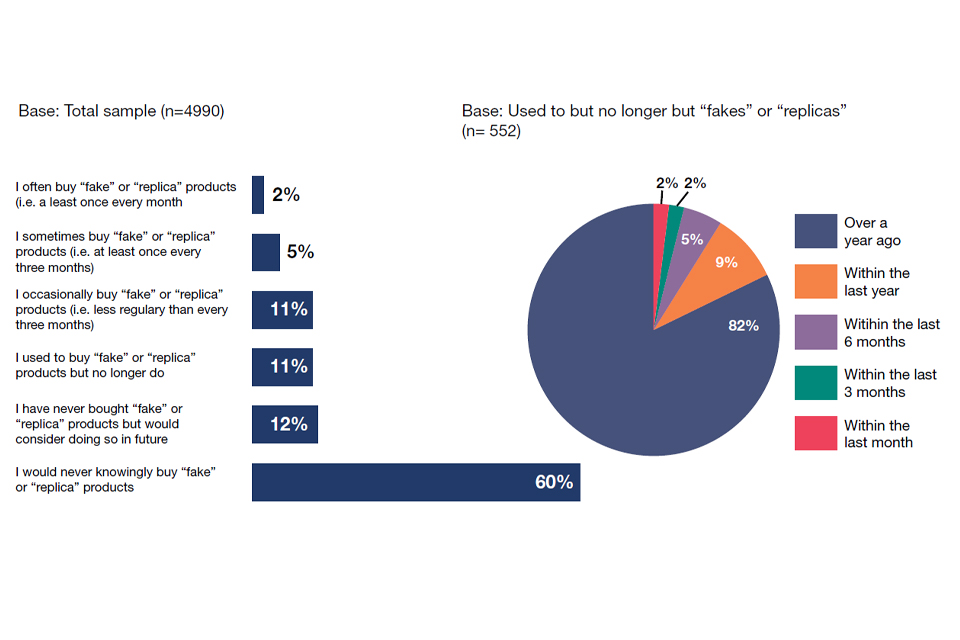
Data represented in graph form for the purchasing of 'fake or replica' items
Incidence of counterfeit purchasing (by age):
- younger respondents (i.e. those aged 18-24 and 25-34) were more likely to indicate that they ‘currently’ (i.e. often, sometimes or occasionally) buy counterfeit items. Approximately three in ten of those aged 18-24 (30%) and 25-34 (31%) ‘currently’ did so compared to progressively lower amounts among older age groups (21% of those aged 35-44, 12% of 45-54s and 9% of the 55+).
- there were no significant differences when looking at the frequency of buying counterfeits by gender.
Q: Which of the following best describes you in relation to purchasing “fake” or “replica” items?
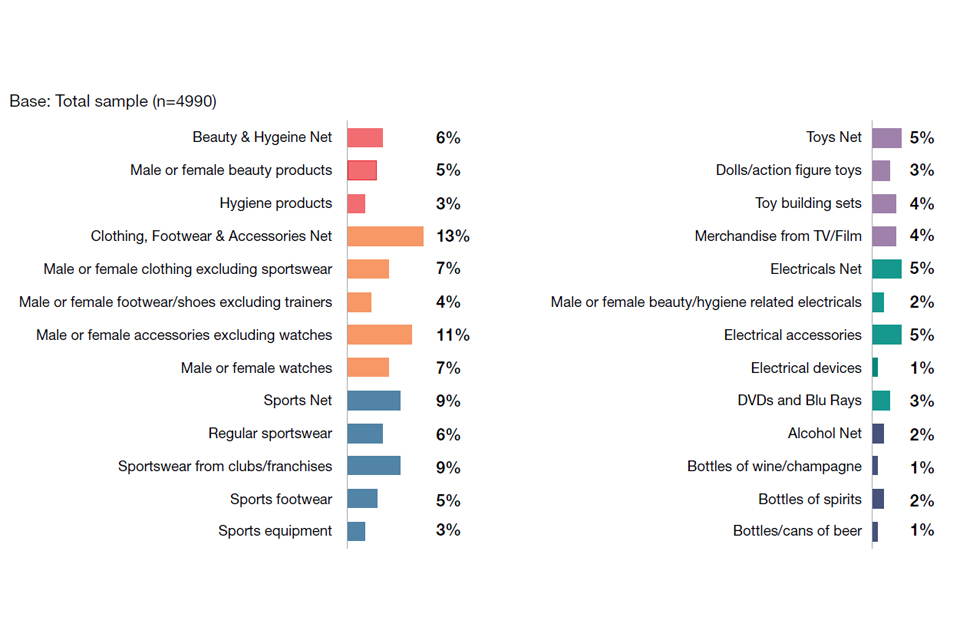
Data represented in percentages of items that are fake or replica bought
Product categories
- the 29% who had knowingly purchased a counterfeit were asked which product categories they had purchased them in within the past year. They were only asked about the categories they had indicated that they had made a purchase in. The below chart shows the proportion of consumers in each product category (broad and individual) who had made a counterfeit purchase.
- respondents were most likely to knowingly have made counterfeit purchases of “Clothing, Footwear and Accessories” and “Sports” products, with 13% and 9% respectively of consumers of those categories having done so in the past year. Other categories experienced notably lower levels of counterfeit purchasing: Beauty & Hygiene (6%), Electricals (5%), Toys (5%) and Alcohol (2%). At an individual product category level, “Male or female accessories excluding watches” (11%) had the highest proportion of counterfeit purchases, closely followed by “Sportswear from clubs/franchises” (9%).
Q: Which, if any, of the following categories have you knowingly purchased “fake” or “replica” products for in the past year?
Base: Consumers in each category - Beauty & Hygiene Net (n=4780), Male Or Female Beauty Products (n=3574), Hygiene Products (n=4594), Clothing Footwear & Accessories Net (n=4538), Male Or Female Clothing Excluding Sportswear (n=4025), Male Or Female Footwear/Shoes Excluding Trainers (n=3504), Male Or Female Accessories Excluding Watches (n=2311), Male Or Female Watches (n=1181), Sports Net (n=2447), Regular Sportswear (n=1604), Sportswear From Clubs/Franchises (n=603), Sports Footwear (n=1719), Sports Equipment (n=617), Toys Net (n=1564), Dolls/Action Figure Toys (n=737), Toy Building Sets (n=919), Merchandise From Tv/Film (n=884), Electricals Net (n=3404), Male Or Female Beauty/Hygiene Related Electricals (n=1306), Electrical Accessories (n=1956), Electrical Devices (n=2148), DVDs and Blu Rays (n=1254), Alcohol Net (n=3759), Bottles Of Wine/ Champagne (n=2665), Bottles Of Spirits (n=2549), Bottles/Cans Of Beer (n=2728)
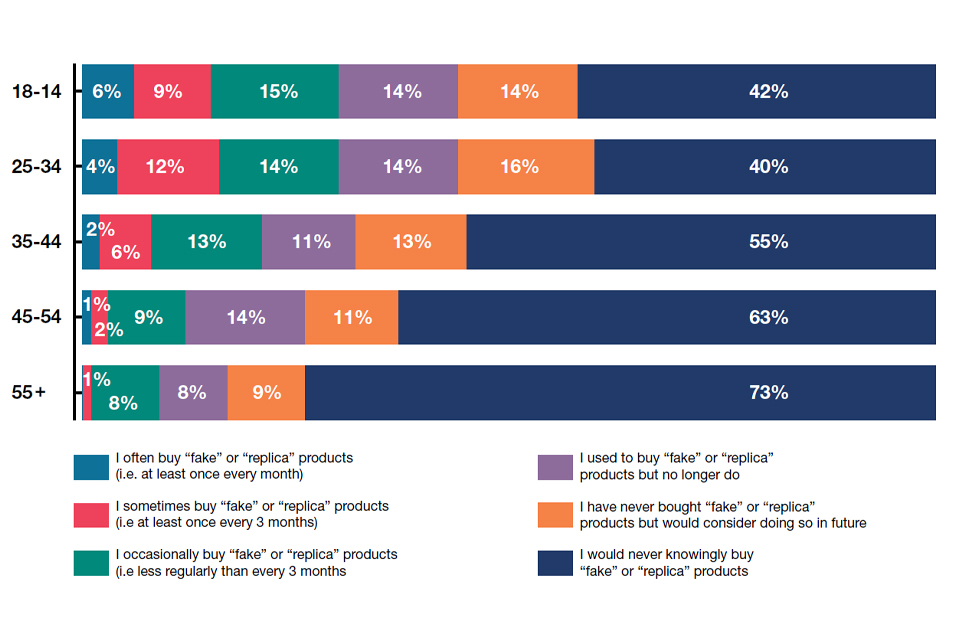
Data represented by age categories of consumers buying fake items
Reasons FOR purchasing counterfeits:
- anyone who had ever purchased (i.e. currently or previously) a counterfeit good or indicated that they would consider doing so in the future was asked about their motivations.
- the main motivation, by some way and consistent across all respondent groups, was cheaper price. No other single motivation was selected by more than a third.
- in terms of satisfaction with products, interesting differences emerged across respondent groups. While all were likely to cite the aesthetics looking similar to legitimate products as a motivation, notably fewer former (i.e. used to) purchasers selected “The quality is similar/the same”. While we cannot say this with confidence, it is possible that experiences with poor quality counterfeit products contribute to consumers no longer purchasing them.
- encouragingly, wanting to damage or deprive brands of money was not a prevalent motivation. Conversely, respondents displayed a strong desire to own legitimate products/associate with brands, however opted to buy counterfeits owing to financial constraints.
Q: What are/were/would be your main reasons for purchasing “FAKE” or “REPLICA” products?
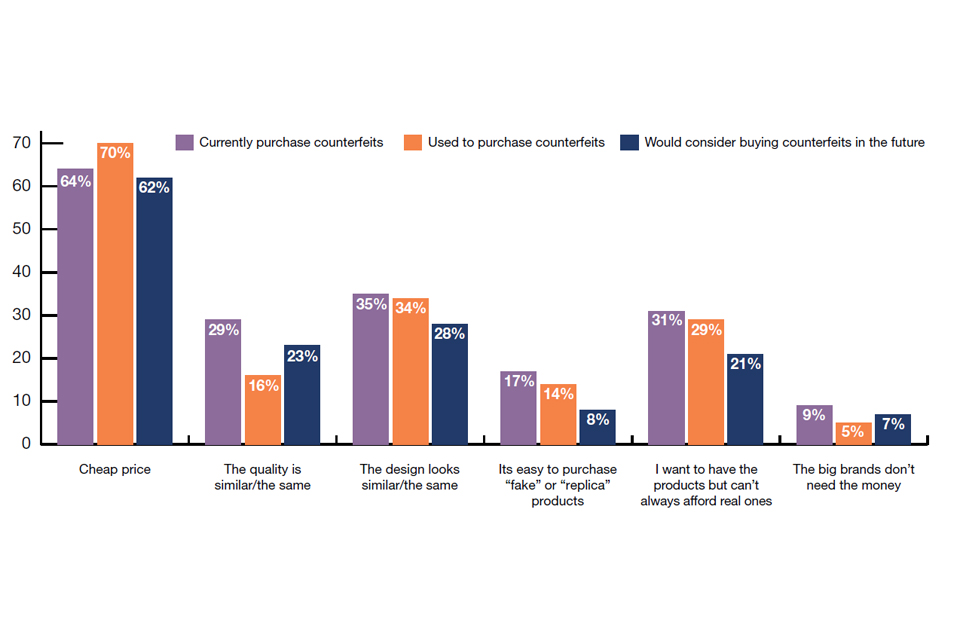
Data graph represented reasons for buying fake/replica items
Reasons for NOT purchasing counterfeits:
- those who did not ‘currently’ (i.e. often, sometimes or occasionally) purchase counterfeit goods were asked why they didn’t. They were grouped into one of the following: would never buy them, used to buy them but wouldn’t any more and those who would consider buying them in the future.
- while no single dominant reason emerged among any of the groups, there were prominent themes. The top three reasons related to moral concerns (i.e. supporting criminal activity and/or use of low cost labour or poor working conditions) and the perceived lower quality of counterfeit products.
- it is perhaps not surprising that a number of reasons resonated more strongly with those who would never buy counterfeits compared to those who either used to or would consider doing so. They were more likely to be ‘worried about supporting criminal activity’ (58%), to think that they ‘harm/damage the real brands’ (45%) and to be worried about the harmful effects (39%).
- looking at lapsed purchasers, again quality emerges as a key barrier to purchase. For this group, and those who would consider purchasing counterfeits, “I do not like the quality of “fake” or “replica” products” was the top reason.
Q: What are/were/would be your main reasons for purchasing “FAKE” or “REPLICA” products?
Base: Would never buy counterfeits (n=2,345), Used to purchase counterfeits (n=552), Would consider buying counterfeits in the future (n=403)
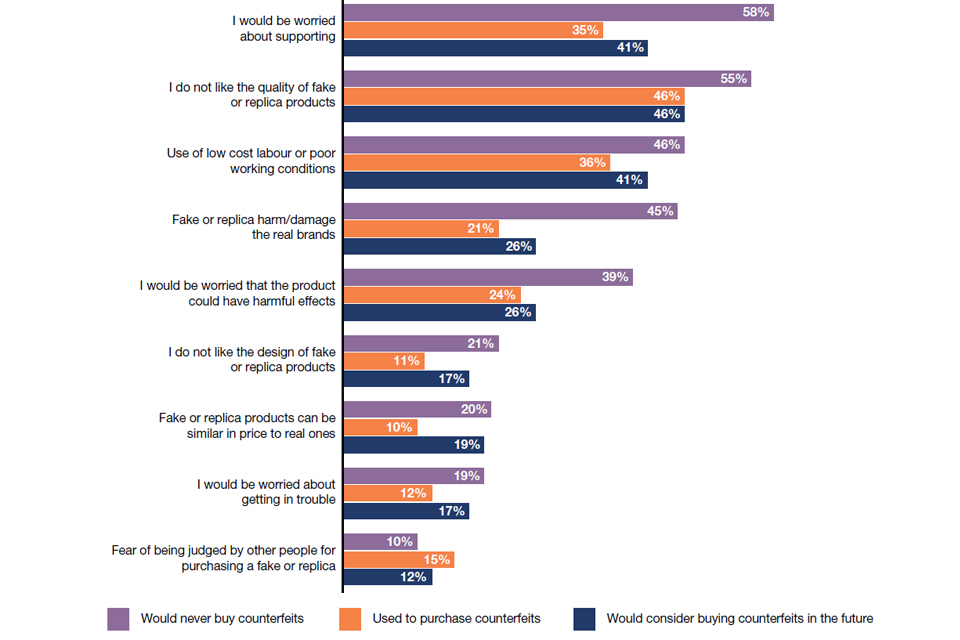
Data showing the main reasons why consumers buy counterfeit
Reasons for NOT purchasing counterfeits (by age):
- a number of areas relating to ethical/moral considerations (worrying about supporting criminal activity, use of low cost labour, harming real brands) resonated more strongly with those aged 45+ (and especially among those aged 55+).
- concerns around quality were fairly consistent across all age groups.
- those aged 18-24 were more likely to have social concerns, with a third (33%) fearing being judged for buying counterfeits.
Q: What are/were/would be your main reasons for purchasing “FAKE” or “REPLICA” products?
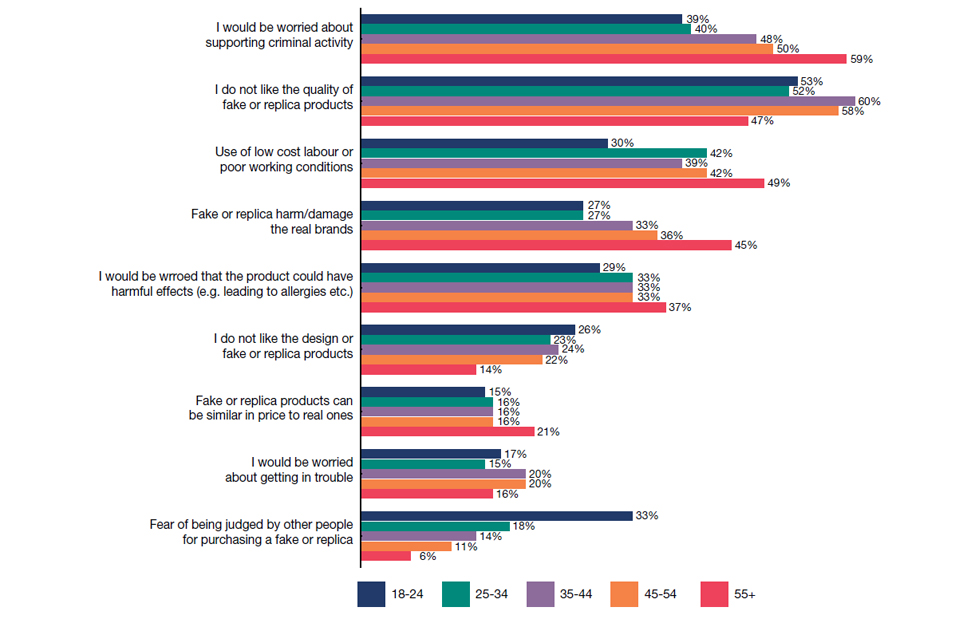
Main reasons for buying counterfeit goods by age bracket
Unintentional counterfeit purchasing:
- 16% of our sample said they had unintentionally purchased counterfeits and were asked from which categories they had been purchased. They were most likely to have unintentionally purchased counterfeit goods in ‘Clothing, Footwear & Accessories’ (6%) and ‘Sports’ (4%)
Q: Which, if any, of the following categories have you unintentionally purchased “fake” or “replica” products for in the past year?
Base: Consumers in each category - Beauty & Hygiene Net (n=4780), Male Or Female Beauty Products (n=3574), Hygiene Products (n=4594), Clothing Footwear & Accessories Net (n=4538), Male Or Female Clothing Excluding Sportswear (n=4025), Male Or Female Footwear/Shoes Excluding Trainers (n=3504), Male Or Female Accessories Excluding Watches (n=2311), Male Or Female Watches (n=1181), Sports Net (n=2447), Regular Sportswear (n=1604), Sportswear From Clubs/Franchises (n=603), Sports Footwear (n=1719), Sports Equipment (n=617), Toys Net (n=1564), Dolls/Action Figure Toys (n=737), Toy Building Sets (n=919), Merchandise From Tv/Film (n=884), Electricals Net (n=3404), Male Or Female Beauty/Hygiene Related Electricals (n=1306), Electrical Accessories (n=1956), Electrical Devices (n=2148), DVDs and Blu Rays (n=1254), Alcohol Net (n=3759), Bottles Of Wine/ Champagne (n=2665), Bottles Of Spirits (n=2549), Bottles/Cans Of Beer (n=2728)
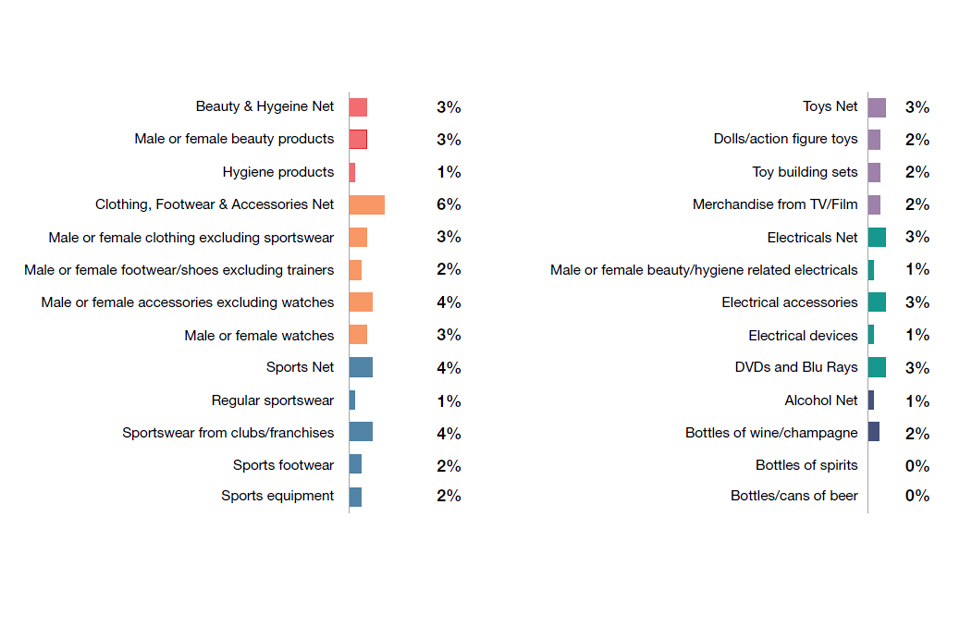
Counterfeit goods which have been unintentionally purchased within the last year
Section 4
Category-level insights
Key insights:
We have reported on data at an overall category level (e.g. ‘Beauty & Hygiene’) and have included detailed questions at a sub-category level (e.g. ‘Beauty products’) where sample sizes are sufficient (i.e. at least 50).
Across all categories respondents from younger age groups (i.e. under 35) were most likely to have purchased counterfeit goods. This was highest in ‘Clothing, Footwear & Accessories’ where approximately one in five of consumers aged 18-24 (21%) and 25-34 (21%) had purchased counterfeit goods.
Across each subcategory the key reason for purchasing counterfeit goods was the cheaper price. Across most sub-categories (where we have a sufficient number of responses) this was followed by respondents saying the the design was the same (e.g. ‘Clothing’, ‘Footwear’, ‘Accessories’ and ‘Sports’). There were also other categories where the quality was perceived to be the same (e.g. ‘Beauty’, ‘Hygiene’ and ‘Electrical accessories’). Across most sub-categories respondents were most likely to say that they were, on average, willing to pay half the price for the counterfeit version, compared to the real thing. The exceptions to this were the following categories where they were most likely to say they were only willing to pay a quarter of the price: Watches (51%), Accessories (49%), Clothing (42%).
Key sources of counterfeit purchasing varied by category:
- in all categories, online via a global e-commerce site was in the top three sources and, in many cases, was the most used source (beauty products, hygiene products, footwear, regular sportwear, sportswear from clubs/franchises, electrical accessories).
- other crucial sources included markets on holiday (most used source for purchasing clothing, accessories, watches and sports footwear) or instore from smaller retailers (most used source for purchasing hygiene products).
It is encouraging to note that, when asked what they would do if they could no longer purchase counterfeits goods, those who said they would go without the product were outnumbered by those who would spend money on either buying the product directly from the brand or on a similar product from a cheaper brand.
Section 5
Communications testing
Informing the communications testing:
The final part of the qualitative element of the study set out to explore the type of messaging which would be most effective in reducing the purchasing of counterfeit products. Two sets of messaging were put together for initial exploration; one showing existing anti-counterfeit campaigns from different regions and organisations and the other stating simple facts and statistics about the impact of the industry or the danger of certain counterfeit goods.
The findings showed that many aspects of the messaging had strong potential to create behaviour change but needed refining in order to maximise their impact and reduce any current detractors to credibility. Largely, reactions to the messages were positive, with many considering for the first time that counterfeiting was not a victimless crime as they had previously thought. However, where there were no statistics or figures to back up certain messages, some were sceptical about the validity of the campaigns, despite saying that the messages would be very persuasive if proven true.
Overall, the messages about electrical goods were seen to be compelling and engaging due to the immediate risk to personal safety and comfort which they posed to the individual or their loved ones. Many reflected on the consequences of unregulated electrical items catching fire or exploding and the figures given on the number of fires caused by counterfeit electricals per year helped persuade participants that this was a legitimate, real life, threat.
The response to other messages which dealt with the impact of counterfeit goods more generally was mixed. Hearing about the impact of the counterfeit trade worldwide surprised and concerned many who were not aware of the implications of purchasing counterfeits. The knowledge that they were in some way potentially contributing to the funding of child labour or other criminal activities proved to be concerning and off putting for many. However, questions around the validity of certain allegations and reports around links to terrorism or related criminal activity lead to a number of people feeling sceptical about the claims being made. They felt that if there was evidence to prove such allegations, they would reconsider their behaviour but that currently these links felt tenuous. Some also felt that while much of the information about child labour and workers’ rights was sad and disheartening, the root cause of counterfeiting lay with the very high prices brands demand for genuine articles while others also highlighted that authentic brands were often also guilty of using child labour and that there was therefore an element of hypocrisy.
Therefore, while many were shocked by the campaigns and said they would reconsider buying counterfeits, there were many people who defended their right to continue purchasing counterfeit goods even after exposure to anti-counterfeit campaigns. In light of these responses, we then bolstered messages with facts and figures where we could, in order to optimise them for quantitative testing.
Development of consumer segments:
These segments were developed from reactions to initial message testing in the qualitative phase. Respondents in the last stage (3) of quantitative research were profiled and categorised into these three segments. They were not mutually exclusive with overlap between the ‘Sceptical’ and ‘Defiant’.
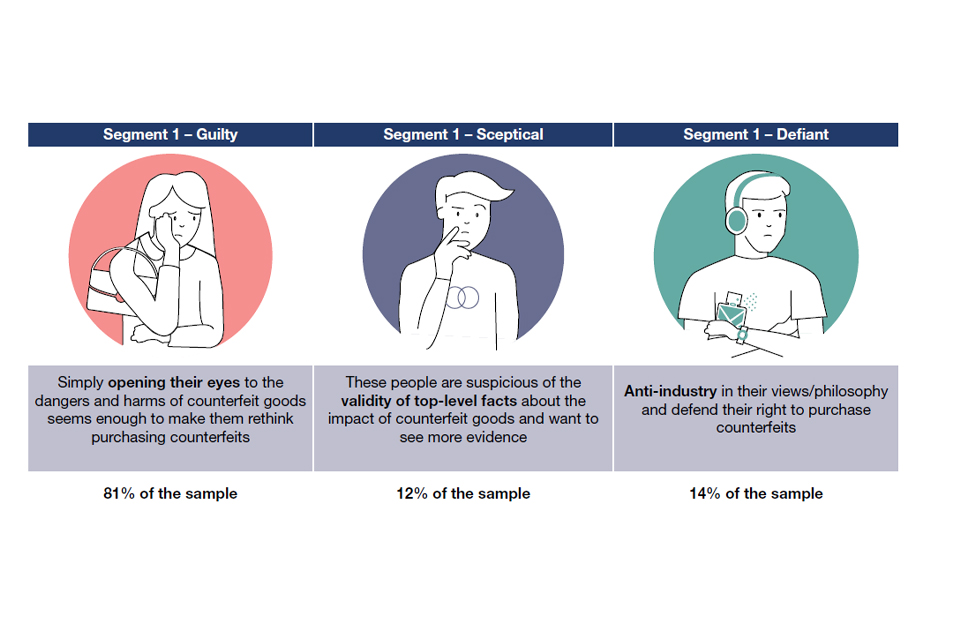
Consumer segments: Guilty, Sceptical and Defiant
Overview of methodology:
The learnings from the qualitative phase informed a second iteration of behaviour change campaign messaging. These broadly fell into one of three categories: Global Impact – Economic; Global Impact – Human and Personal Impact. The messages were tested with (n=1,010) respondents who were non-rejectors of either purchasing or receiving counterfeit goods. For the purposes of consistency, images were removed and all messages were shown purely in text form. Given feedback from respondents around credibility, some messages were bolstered with further statistics. The messages were tested in four surveys which were live between November and December 2019.
Global impact (Economic)
- figures from the UK government show that the annual loss to the economy through counterfeiting and piracy is £9 billion, plus 80,500 job losses each year.
- EUIPO research estimates that counterfeits such as bags, clothing and electrical goods cost the EU €60 billion, as well as 434,000 job losses each year.
- according to the International Chamber of Commerce, governments across countries miss out on around $89 billion per year through the loss of sales tax on counterfeit products, meaning less public money to use on schools, roads and hospitals.
- legitimate companies face competition from counterfeiters who steal their intellectual property without paying taxes or complying with quality standards. This damages the legitimate brand’s reputation, profit and workforce
Global impact (Human)
- counterfeiting has a considerable impact on the rights of workers around the globe. The lack of control over working conditions and respect of employment rights places workers who produce counterfeit goods, many of them children, in very vulnerable positions.
- according to the United Nations Commission on Crime Prevention and Criminal Justice, counterfeiting is now the second largest source of criminal income worldwide.
- there are proven links between the sale of counterfeit goods and the funding of terrorist operations and of prominent groups such as Isis, the IRA, Al Qaïda etc. For example, police believe the perpetrators of the Charlie Hebdo attacks sold counterfeit Nike trainers in order to fund the weapons they used.
- according to police, this year has seen an increase in incidents of counterfeiting operations in the UK that are linked to organised criminal groups, human trafficking, child sexual exploitation and prostitution.
Personal Impact
- in England alone, between 2017-2018, faulty domestic appliances were responsible for 2,764 domestic fires – over 7 a day on average.
- in April 2018, the LAPD raided the city’s fashion district and seized $700,000 worth of counterfeit cosmetics after customers complained of bumps and rashes. Test results showed the products contained high levels of bacteria and animal waste.
- criminals behind websites selling counterfeit goods may use your card details and personal information for other fraudulent scams.
- in France, buying or carrying a counterfeit product is a criminal offence punishable by up to 3 years imprisonment and a €300,000 fine. This law applies to anyone, local or tourist, on French territory in possession of a counterfeit product.
Overview of messaging effectiveness:
Global impact (Human) messaging
The most effective messaging overall in persuading people not to buy counterfeits fell within the ‘Global Impact (Human)’ category. It was said to be effective by more than half of our sample (55%) and related to the links between terrorism and physical counterfeits. The second most effective (selected by 43%) highlighted the links between counterfeits and criminal originations/activity.
There was one piece of messaging in this category which was not as effective, ’According to the United Nations Commission on Crime Prevention and Criminal Justice, counterfeiting is now the second largest source of criminal income worldwide’, which was selected by only 12%. This could be because, compared with other messages in this category, it lacked concrete examples of the harmful effects of purchasing counterfeits on people.
Personal impact messaging
The four pieces of messaging which emphasised the Personal Impact to consumers were all consistent in terms of overall effectiveness. All four of the messages tested were selected by between 24-29% of our sample.
Personal impact messaging
The four pieces of messaging which emphasised the Personal Impact to consumers were all consistent in terms of overall effectiveness. All four of the messages tested were selected by between 24-29% of our sample.
Why the messaging was unlikely to change minds
Those who said a piece of messaging was unlikely to change their mind were asked the reasons why (via a pre-coded question). The answers across all of the messaging categories followed a similar pattern, with respondents most likely to say that they would need more information. There was also a minority, ranging from 17-31% across all messages, who were sceptical and felt that those publishing them have their own agendas.
Messaging effectiveness (full results):
Which of these messages do you think would be most effective in persuading you not to buy or receive “Fake” OR “Replica” goods in the future? Please rank your top three messages in order of effectiveness.
Base: Would never buy counterfeits (n=2,345), Used to purchase counterfeits (n=552), Would consider buying counterfeits in the future (n=403)
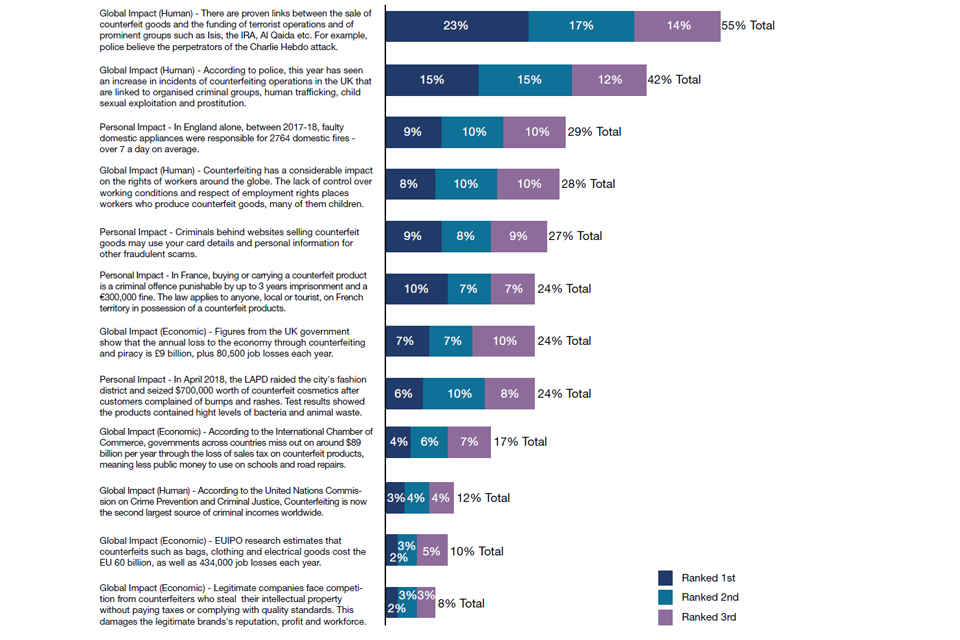
Data represented by message effectiveness on persuading consumers not to buy fake goods
Feedback on Global Impact (Human) Messaging:
Message 1 - Counterfeiting has a considerable impact on the rights of workers around the globe. The lack of control over working conditions and respect of employment rights places workers who produce counterfeit goods, many of them children, in very vulnerable positions.
Message 2 - According to the United Nations Commission on Crime Prevention and Criminal Justice, counterfeiting is now the second largest source of criminal income worldwide.
Message 3 - There are proven links between the sale of counterfeit goods and the funding of terrorist operations and of prominent groups such as Isis, the IRA, Al Qaïda etc. For example, police believe the perpetrators of the Charlie Hebdo attacks sold counterfeit Nike trainers in order to fund the weapons they used.
Message 4 - According to police, this year has seen an increase in incidents of counterfeiting operations in the UK that are linked to organised criminal groups, human trafficking, child sexual exploitation and prostitution.
Q. Thinking about the information we just showed you. How surprised did it make you feel?
| Message 1 | Message 2 | Message 3 | Message 4 | |
|---|---|---|---|---|
| Extremely surprised | 9% | 21% | 36% | 27% |
| Very surprised | 22% | 34% | 29% | 28% |
| Moderately surprised | 30% | 23% | 19% | 23% |
| Slightly surprised | 15% | 11% | 9% | 13% |
| Not at all surprised | 25% | 11% | 8% | 10% |
Q. Were you previously aware of the information we showed you?
| Message 1 | Message 2 | Message 3 | Message 4 | |
|---|---|---|---|---|
| I was aware of all of it | 10% | 5% | 4% | 5% |
| I was aware of most of it | 28% | 17% | 12% | 15% |
| I was aware of some of it | 44% | 33% | 20% | 32% |
| I was not aware | 18% | 44% | 64% | 48% |
| I was aware of all of it | 10% | 5% | 4% | 5% |
Q. How likely, if at all, is it that the information we showed you would prevent you from buying or receiving “fake” or “replica” products in the future?
| Message 1 | Message 2 | Message 3 | Message 4 | |
|---|---|---|---|---|
| Very likely | 37% | 43% | 62% | 59% |
| Somewhat likely | 36% | 32% | 21% | 24% |
| Neither likely nor unlikely | 17% | 16% | 11% | 11% |
| Somewhat unlikely | 7% | 7% | 4% | 3% |
| Very unlikely | 2% | 2% | 3% | 3% |
Q. Why is the information we showed you unlikely to change your mind?
| Message 1 (base n=255) |
Message 2 (base n=253) | Message 3 (base n=172) | Message 4 (base n=170) | |
|---|---|---|---|---|
| I don’t believe the information is true | 8% | 13% | 22% | 22% |
| I would need further information | 63% | 61% | 55% | 60% |
| I think the people publishing this have their own agenda | 19% | 21% | 29% | 23% |
| I think it is an attempt to disadvantage people like me | 15% | 14% | 19% | 20% |
| Other | 12% | 9% | 8% | 6% |
Why Global Impact (Human) messaging was effective:
Messages about the way in which the counterfeit trade impacts other people around the world were seen as very effective owing to the fact that there had previously been such low awareness of the human cost of the industry. Learning that by purchasing counterfeits they were involved in the funding of criminal activity, especially terrorism and the exploitation of children, many felt it would be selfish to continue purchasing counterfeit goods simply to feel good and save money while others were suffering.
Q. What is it you find effective about this message?
Message 1 - Counterfeiting has a considerable impact on the rights of workers around the globe. The lack of control over working conditions and respect of employment rights places workers who produce counterfeit goods, many of them children, in very vulnerable positions.
- “it puts vulnerable children in danger and exploits workers, many of whom don’t have any choice but to work under terrible conditions. We shouldn’t be buying cheap, counterfeit goods.”
- “the human element, not financial only, the workers employed in sub standard conditions with no rights of appeal against abuse etc. Children should be at school not having to support their families.”
Message 2 - According to the United Nations Commission on Crime Prevention and Criminal Justice, counterfeiting is now the second largest source of criminal income worldwide.
- “because it shows that a supposedly ‘harmless’ crime where no one gets hurt is such a huge contributor to criminal income.”
- “it is shocking to read. The second largest source of income is surprising and shouldn’t happen.”
Message 3 - There are proven links between the sale of counterfeit goods and the funding of terrorist operations and of prominent groups such as Isis, the IRA, Al Qaïda etc. For example, police believe the perpetrators of the Charlie Hebdo attacks sold counterfeit Nike trainers in order to fund the weapons they used.
- “because it makes the impact so real, it’s not just about having a cheap item it’s about playing a part in the death of people, helping to fund the criminals and terrorists just to look good.”
- “terrorism has become more prominent in people’s minds nowadays so I think this message shows a way that the general public can play a part in preventing it.”
- “I did not realise there was such a big link between fake goods and terrorist groups.”
Message 4 - According to police, this year has seen an increase in incidents of counterfeiting operations in the UK that are linked to organised criminal groups, human trafficking, child sexual exploitation and prostitution.
-
“makes you aware of the victims of the crime being children and the kinds of criminal activities that are linked to the profits - the fact it is linked to the UK makes it particularly relevant.”
-
“I had never realised the link between organised crime & counterfeit goods before & it scares me that by buying fake branded products we would be encouraging sexual exploitation etc.”
Feedback on Personal Impact Messaging:
Message 5 - In England alone, between 2017 - 2018, faulty domestic appliances were responsible for 2764 domestic fires – over 7 a day on average.
Message 6 - In April 2018, the LAPD raided the city’s fashion district and seized $700,000 worth of counterfeit cosmetics after customers complained of bumps and rashes. Test results showed the products contained high levels of bacteria and animal waste.
Message 7 - Criminals behind websites selling counterfeit goods may use your card details and personal information for other fraudulent scams.
Message 8 - In France, buying or carrying a counterfeit product is a criminal offence punishable by up to 3 years imprisonment and a €300,000 fine. This law applies to anyone, local or tourist, on French territory in possession of a counterfeit product.
Q. Thinking about the information we just showed you. How surprised did it make you feel?
| Message 5 | Message 6 | Message 7 | Message 8 | |
|---|---|---|---|---|
| Extremely surprised | 26% | 32% | 11% | 43% |
| Very surprised | 33% | 29% | 4% | 28% |
| Moderately surprised | 20% | 21% | 21% | 18% |
| Slightly surprised | 9% | 9% | 14% | 8% |
| Not at all surprised | 11% | 9% | 41% | 4% |
Q. Were you previously aware of the information we showed you?
| Message 5 | Message 6 | Message 7 | Message 8 | |
|---|---|---|---|---|
| I was aware of all of it | 3% | 4% | 16% | 3% |
| I was aware of most of it | 14% | 9% | 27% | 8% |
| I was aware of some of it | 33% | 21% | 35% | 10% |
| I was not aware | 50% | 66% | 22% | 79% |
| I was aware of all of it | 3% | 4% | 16% | 3% |
Q. How likely, if at all, is it that the information we showed you would prevent you from buying or receiving “fake” or “replica” products in the future?
| Message 5 | Message 6 | Message 7 | Message 8 | |
|---|---|---|---|---|
| Very likely | 54% | 64% | 64% | 62% |
| Somewhat likely | 26% | 20% | 22% | 19% |
| Neither likely nor unlikely | 13% | 10% | 9% | 12% \ |
| Somewhat unlikely | 5% | 3% | 3% | 4% |
| Very unlikely | 2% | 3% | 3% | 3% |
Q. Why is the information we showed you unlikely to change your mind?
| Message 5 (base n=195) |
Message 6 (base n=158) |
Message 7 (base n=146) |
Message 8 (base n=189) |
|
| I don’t believe the information is true | 5% | 9% | 8% | 13% |
| I would need further information | 61% | 54% | 55% | 39% |
| I think the people publishing this have their own agenda | 17% | 18% | 23% | 19% |
| I think it is an attempt to disadvantage people like me | 11% | 17% | 17% | 21% |
| Other | 21% | 14% | 12% | 24% |
Why Personal Impact messaging was effective:
Messages about the potential risk of counterfeit goods to oneself or one’s family were seen as immediately impactful and, in many cases, alarming and a big deterrent. Messages about potential physical harm were particularly effective due to the threat to personal safety or to loved ones. The presence of statistics and case studies in many examples helped highlight the idea that risks were common and could easily affect anyone in possession of counterfeit goods.
Q. What is it you find effective about this message?
Message 5 - In England alone, between 2017-2018, faulty domestic appliances were responsible for 2764 domestic fires - over 7 a day on average.
- “the consequences of a home fire and possible risk to life and loss of home and possessions in itself is a powerful and poignant fact and message of deterrent.”
- “it shows the risk and safety hazard very clearly and thus it is made very easy to see how dangerous counterfeit items are.”
- “its closer to home. If a house fire starts it is your family at risk. It is more immediate than some of the other options. Even though all of them are very important.”
- “this is a shocking message. It tells me that counterfeit goods which are unsafe could put my family’s life at risk.”
Message 6 - In April 2018, the LAPD raided the city’s fashion district and seized $700,000 worth of counterfeit cosmetics after customers complained of bumps and rashes. Test results showed the products contained high levels of bacteria and animal waste.
- “this would really put me off buying any cosmetics if I don’t know they are legitimate and they contain animal waste potentially it isn’t worth it.”
- “I find it disgusting that it contains animal waste and bacteria and I think it is very scary. It has completely put me off.”
- “saying that people were coming out in rashes from wearing the items is really off putting.”
Message 7 - Criminals behind websites selling counterfeit goods may use your card details and personal information for other fraudulent scams.
- “fraud like this is a big worry for people and I think this would make them think twice about giving their details to pay for counterfeit goods.”
- “I feel this way because it nearly happened to me, but I was lucky the credit card fraud department reimbursed me and my card was stopped immediately, and a new one arrived in 3 days. It really gave me a fright because they were so convincing and there were no red flags alarming me that they were counterfeit.”
Message 8 - In France, buying or carrying a counterfeit product is a criminal offence punishable by up to 3 years imprisonment and a €300,000 fine. This law applies to anyone, local or tourist, on French territory in possession of a counterfeit product.
- “it emphasises that having counterfeit goods in your possession is a criminal offence, having a punishable prison sentence of up to 3 years plus a further €300,000 fine, even a tourist carrying such will receive the same sentence, so therefore I think this is the most effective.”
- “this sends a very clear and strong message that counterfeit goods have no place in society, and that maybe the French law should be rolled out across the board.”
- “I am shocked that even carrying a counterfeit product may earn you a 3 year prison sentence or a fine of €300,000.”
Feedback on Global Impact (Economic) Messaging:
Message 9 - Figures from the UK government show that the annual loss to the economy through counterfeiting and piracy is £9 billion, plus 80,500 job losses each year.
Message 10 - EUIPO research estimates that counterfeits such as bags, clothing and electrical goods cost the EU €60 billion, as well as 434,000 job losses each year.
Message 11 - According to the International Chamber of Commerce, governments across countries miss out on around $89 billion per year through the loss of sales tax on counterfeit products, meaning less public money to use on schools, roads and hospitals.
Message 12 - Legitimate companies face competition from counterfeiters who steal their intellectual property without paying taxes or complying with quality standards. This damages the legitimate brand’s reputation, profit and workforce.
Q. Thinking about the information we just showed you. How surprised did it make you feel?
| Message 9 | Message 10 | Message 11 | Message 12 | |
|---|---|---|---|---|
| Extremely surprised | 24% | 25% | 24% | 11% |
| Very surprised | 38% | 36% | 34% | 21% |
| Moderately surprised | 24% | 23% | 23% | 27% |
| Slightly surprised | 9% | 12% | 13% | 17% |
| Not at all surprised | 6% | 4% | 7% | 25% |
Q. Were you previously aware of the information we showed you?
| Message 9 | Message 10 | Message 11 | Message 12 | |
|---|---|---|---|---|
| I was aware of all of it | 3% | 3% | 2% | 11% |
| I was aware of most of it | 10% | 11% | 11% | 27% |
| I was aware of some of it | 35% | 33% | 31% | 37% |
| I was not aware | 52% | 53% | 55% | 25% |
| I was aware of all of it | 3% | 3% | 2% | 11% |
Q. How likely, if at all, is it that the information we showed you would prevent you from buying or receiving “fake” or “replica” products in the future?
| Message 9 | Message 10 | Message 11 | Message 12 | |
|---|---|---|---|---|
| Very likely | 37% | 38% | 41% | 36% |
| Somewhat likely | 34% | 34% | 31% | 31% |
| Neither likely nor unlikely | 18% | 16% | 16% | 23% |
| Somewhat unlikely | 8% | 9% | 8% | 7% |
| Very unlikely | 3% | 3% | 4% | 4% |
Q. Why is the information we showed you unlikely to change your mind?
| Message 9 (base n=293) |
Message 10 (base n=283) |
Message 11 (base n=283) |
Message 12 (base n=336) |
|
|---|---|---|---|---|
| I don’t believe the information is true | 18% | 22% | 26% | 11% |
| I would need further information | 57% | 54% | 48% | 53% |
| I think the people publishing this have their own agenda | 29% | 31% | 36% | 32% |
| I think it is an attempt to disadvantage people like me | 21% | 21% | 22% | 19% |
| Other | 9% | 11% | 11% | 10% |
Why Global Impact (Economic) messaging was effective:
Though not as emotionally resonant as the messages about the human impact of counterfeits, the facts and figures around the economic consequences of the counterfeit trade opened many peoples’ eyes to the everyday impact counterfeits have on a broad scale. Relating counterfeits to job losses or losses to the economy resulted in many reflecting on the idea of the counterfeit trade being a drain on society and how ordinary people might be impacted by the effects of the trade in the workplace or infrastructure across the UK.
Q. What is it you find effective about this message?
Message 9 - Figures from the UK government show that the annual loss to the economy through counterfeiting and piracy is £9 billion, plus 80,500 job losses each year.
- “it is a UK based message rather than a global, American or European message that always dilutes the impact. It shows the amount of money lost as well as job losses and thus this can have a direct impact on people’s existence.”
- “I never thought about the huge impact it has on government, tax and people’s jobs, you think of it as a victimless crime but innocent people lose work because of it.”
- “all the money not paying taxes etc. would provide income for the NHS & other public services.”
Message 10 - IEUIPO research estimates that counterfeits such as bags, clothing and electrical goods cost the EU €60 billion, as well as 434,000 job losses each year.
- “it shows how much the problem impacts the jobs market which is an effective way to get people thinking about it all.”
- “it’s literally stealing jobs, loads of them, and a very disgraceful way to make money.”
Message 11 - According to the International Chamber of Commerce, governments across countries miss out on around $89 billion per year through the loss of sales tax on counterfeit products, meaning less public money to use on schools, roads and hospitals.
- “the large amount of money involved. Makes you realise how much it could go toward helping the country.”
- “I think is wrong that schools and hospitals should lose out to this happening and it should be stopped.”
Message 12 - Legitimate companies face competition from counterfeiters who steal their intellectual property without paying taxes or complying with quality standards. This damages the legitimate brand’s reputation, profit and workforce.
- “raises awareness about how brands can be damaged.”
- “it is clearly true (unlike many of the other statements, which are unsupported assertions).
Impact of Messaging on Consumer Segments:
After viewing the messaging, 63% stated that they would no longer purchase counterfeits. 5% would buy counterfeits at the same rate or more frequently and 10% would still buy them but would do so less frequently. A majority (81%) would no longer be open to receiving them as gifts.
After having viewed the messaging they would…
| Segment 1 - Guilty |
Segment 2 -Sceptical |
Segment 3 - Defiant |
|
|---|---|---|---|
| Buy counterfeits at the same rate or more frequently | 3% | 15% | 10% |
| Buy them less often | 7% | 21% | 29% |
| Not buy them at all | 66% | 50% | 49% |
| Not be open to receiving them as gifts | 87% | 55% | 59% |
For any questions please don’t hesitate to contact:
-
Sania Haq sania@audiencenet.co.uk -
Issac Schling issac@audiencenet.co.uk -
Laura-Jane Taylor Laura-jane@audiencenet.co.uk
